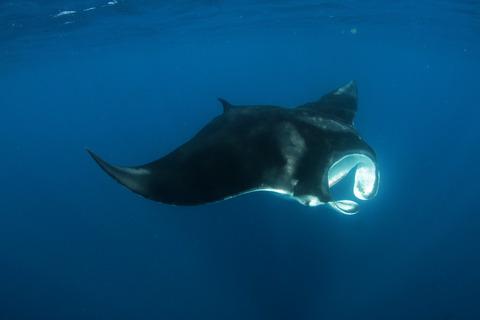当前位置:
X-MOL 学术
›
Anim. Conserv.
›
论文详情
Our official English website, www.x-mol.net, welcomes your
feedback! (Note: you will need to create a separate account there.)
Ecological niche modeling reveals manta ray distribution and conservation priority areas in the Western Central Atlantic
Animal Conservation ( IF 2.8 ) Pub Date : 2020-11-29 , DOI: 10.1111/acv.12663 F. Garzon 1, 2 , R. T. Graham 3 , M. J. Witt 2 , L. A. Hawkes 2
Animal Conservation ( IF 2.8 ) Pub Date : 2020-11-29 , DOI: 10.1111/acv.12663 F. Garzon 1, 2 , R. T. Graham 3 , M. J. Witt 2 , L. A. Hawkes 2
Affiliation

|
The Western Central Atlantic (WCA) hosts a population of manta rays whose distribution and habitat preference is poorly understood. Addressing this lack of knowledge will be essential to aid the effective implementation of targeted conservation measures. Here, we use ensemble ecological niche modeling to predict the monthly distribution of manta rays in the WCA using multiple sources of species occurrence data, and consequently identify core areas, which represent suitable habitat in all months of the year. Models suggest a seasonal cycle of expansion and contraction of suitable habitat from coastal areas in spring-summer, to open ocean in autumn-winter. Core areas are concentrated along the coast of the USA, Mexico, and Venezuela. Only 24% of predicted suitable habitat is encompassed by the present regional network of MPAs, and is intersected by numerous, heavily trafficked shipping lanes. Manta rays are slow-growing animals that only produce a limited number of offspring; as such, this species is sensitive to even moderate increases in mortality rates. For this reason, the existing regional network of MPAs may offer them limited protection. As manta rays in the WCA are challenged by a complex landscape of threats and protective measures, future marine conservation planning in the region should explicitly address the conservation of manta rays, focusing on areas identified as key habitats for the species.
中文翻译:

生态位模型揭示了中西部大西洋的蝠鲼分布和保护优先区域
中西部大西洋 (WCA) 栖息着一群蝠鲼,它们的分布和栖息地偏好知之甚少。解决这种知识缺乏对于帮助有效实施有针对性的保护措施至关重要。在这里,我们使用集合生态位模型来预测 WCA 中蝠鲼的月分布,使用多个物种发生数据来源,从而确定核心区域,代表一年中所有月份的合适栖息地。模型表明,适宜栖息地从春夏季的沿海地区到秋季-冬季的开阔海域有一个季节性的扩张和收缩周期。核心区集中在美国、墨西哥和委内瑞拉沿海。目前的海洋保护区区域网络仅包含 24% 的预测适宜栖息地,并与众多交通繁忙的航道相交。蝠鲼是生长缓慢的动物,只能产生有限数量的后代。因此,该物种对死亡率的适度增加很敏感。因此,现有的海洋保护区区域网络可能为它们提供有限的保护。由于 WCA 中的蝠鲼面临着复杂的威胁和保护措施的挑战,该地区未来的海洋保护规划应明确解决蝠鲼的保护问题,重点关注被确定为该物种主要栖息地的区域。现有的海洋保护区区域网络可为它们提供有限的保护。由于 WCA 中的蝠鲼面临着复杂的威胁和保护措施的挑战,该地区未来的海洋保护规划应明确解决蝠鲼的保护问题,重点关注被确定为该物种主要栖息地的区域。现有的海洋保护区区域网络可为它们提供有限的保护。由于 WCA 中的蝠鲼面临着复杂的威胁和保护措施的挑战,该地区未来的海洋保护规划应明确解决蝠鲼的保护问题,重点关注被确定为该物种主要栖息地的区域。
更新日期:2020-11-29
中文翻译:

生态位模型揭示了中西部大西洋的蝠鲼分布和保护优先区域
中西部大西洋 (WCA) 栖息着一群蝠鲼,它们的分布和栖息地偏好知之甚少。解决这种知识缺乏对于帮助有效实施有针对性的保护措施至关重要。在这里,我们使用集合生态位模型来预测 WCA 中蝠鲼的月分布,使用多个物种发生数据来源,从而确定核心区域,代表一年中所有月份的合适栖息地。模型表明,适宜栖息地从春夏季的沿海地区到秋季-冬季的开阔海域有一个季节性的扩张和收缩周期。核心区集中在美国、墨西哥和委内瑞拉沿海。目前的海洋保护区区域网络仅包含 24% 的预测适宜栖息地,并与众多交通繁忙的航道相交。蝠鲼是生长缓慢的动物,只能产生有限数量的后代。因此,该物种对死亡率的适度增加很敏感。因此,现有的海洋保护区区域网络可能为它们提供有限的保护。由于 WCA 中的蝠鲼面临着复杂的威胁和保护措施的挑战,该地区未来的海洋保护规划应明确解决蝠鲼的保护问题,重点关注被确定为该物种主要栖息地的区域。现有的海洋保护区区域网络可为它们提供有限的保护。由于 WCA 中的蝠鲼面临着复杂的威胁和保护措施的挑战,该地区未来的海洋保护规划应明确解决蝠鲼的保护问题,重点关注被确定为该物种主要栖息地的区域。现有的海洋保护区区域网络可为它们提供有限的保护。由于 WCA 中的蝠鲼面临着复杂的威胁和保护措施的挑战,该地区未来的海洋保护规划应明确解决蝠鲼的保护问题,重点关注被确定为该物种主要栖息地的区域。











































 京公网安备 11010802027423号
京公网安备 11010802027423号